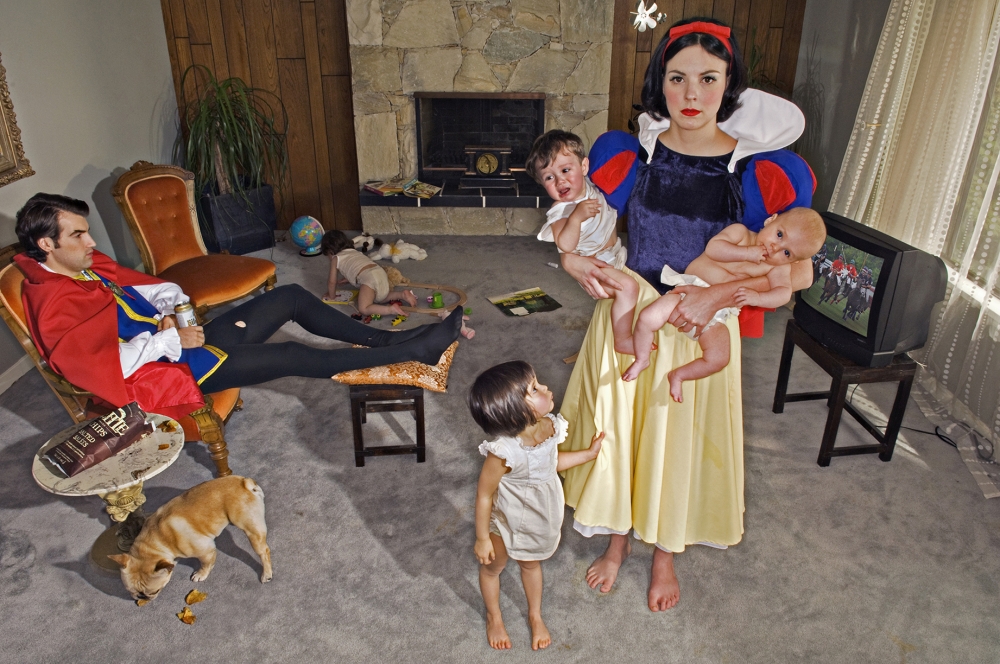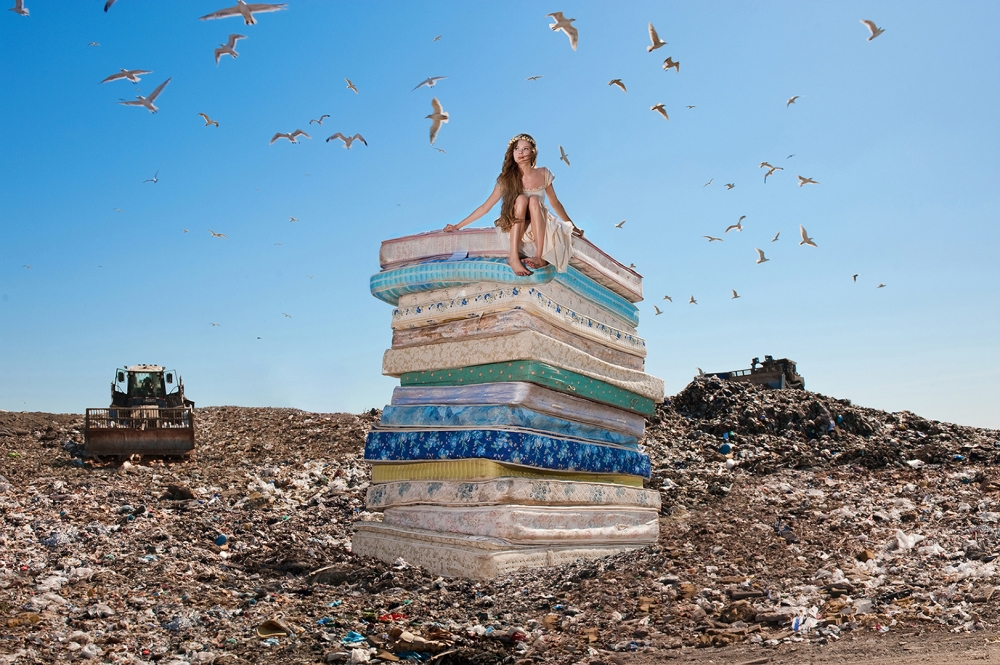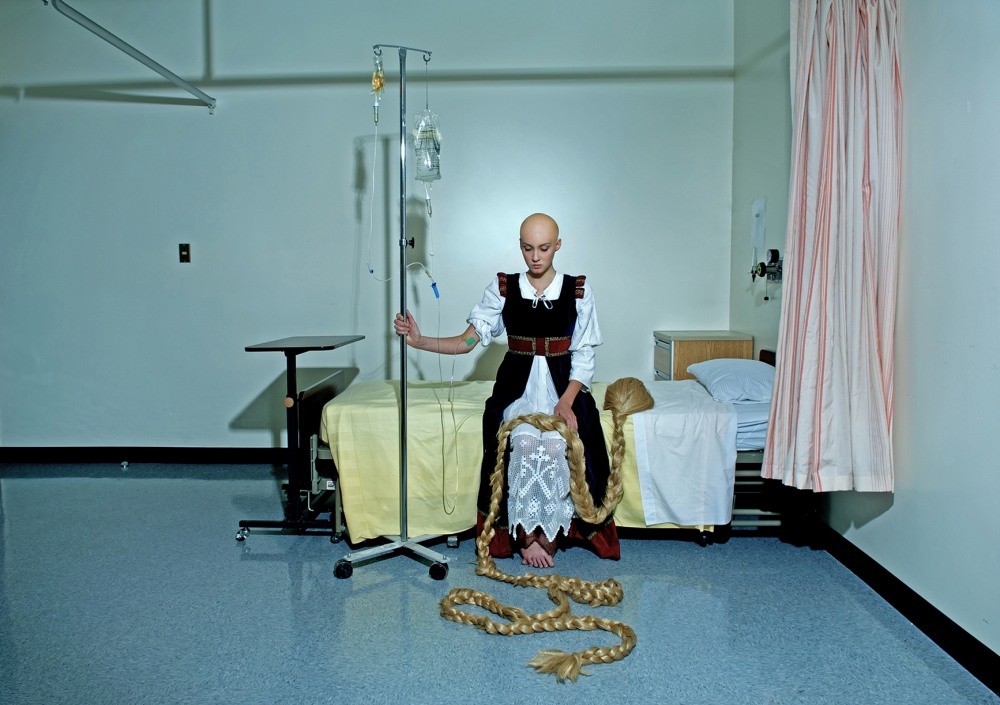




Subverting the Myth of Happiness: Dina Goldstein's "Fallen Princesses" Jack Zipes
When feminists began -re-writing fairy tales in the 1960s and 1970s, one of their major purposes was to demonstrate that nobody really lives happily ever after, whether in fantasy or reality, and one of the important political assumptions was that nobody will ever live happily ever after unless we change not only fairy-tale writing but social and economic conditions that further exploitative and oppressive relations among the sexes, races, and social classes. This general purpose is still at the root of the best and most serious writing of fairy tales by women, and in recent years, some of the best women painters, artists, photographers, and filmmakers in North America have created unique works that question traditional representations of gender, marriage, work, and social roles.
In order to explain why nobody lives happily ever after, neither in fairy tales nor in real life, and why nobody should invest their time and energy believing in a "happily ever after" realm, I would like to make a few comments about Dina Goldstein's provocative photographs that pierce the myth of happiness. This is not to say that we cannot be happy in our lives. Rather, I should like to suggest that the fairy-tale notion about happiness must be radically turned on its head if we are to glimpse the myths of happiness perpetuated by the canonical fairy tales and culture industry and to determine what happiness means.
Anyone who has seen Dina Goldstein's unusual photographs knows that she not only deflowers fairy tales with her tantalizing images, but she also "de-disneyfies" them. Goldstein came to Canada from Israel when she was eight-years-old and had very little experience with the world of Disney films, books, artifacts, and advertisements. It was
1

not until she was much older, when her three-year-old daughter was exposed to the Disney princesses, and when her mother was diagnosed with breast cancer that she began to reflect about the impact of the Disneyfied fairy tales. As she has said in an interview with the Vancouver Sun, "I began to imagine Disney's perfect princesses juxtaposed with real issues that were affecting women around me, such as illness, cancer, addiction and self-image issues. . . . Disney princesses didn't have to deal with these issues, and besides we really never followed their life past their youth."
Goldstein's photo series, "Fallen Princesses," first appeared on the Internet in the summer of 2009, and they have received global attention as artworks that comment critically on the Disney world and raise many questions about the lives women are expected to lead and the actual lives that they lead. Her photos are not optimistic. Rather, they are subtle, comic, and grotesque images that undo classical fairy-tale narratives and expose some of the negative results that are rarely discussed in public.
For instance, in her macabre portrayal of Snow White, she depicts the gruesome fate of a young woman, who is the spitting image of Disney's Barbie heroine. She stands in the middle of a suburban living room holding two of her children in diapers, one crying, one sucking her thumb. Another daughter is pulling on her skirt, while a fourth is crawling in a corner of the room. A tiny bulldog is sniffing the ground. The woman stares solemnly into the camera while her prince-like husband sits on an easy chair and watches a sporting event on television. Of course, he is holding a can of beer and is totally detached from his family. In another photo in the series, Snow White and her prince stare into the camera, completely alienated from one another. Whatever love there was between then has vanished.
2

Is this what marriage and family life are supposed to be? Goldstein does not generalize, for these are very specific social-class images that may resonate with viewers from all classes in different ways. If anything, Goldstein is concerned with the struggles that women must endure despite the gains made by the feminist movement in the past forty years. Her Rapunzel loses her hair perhaps due to chemotherapy. Her Belle undergoes plastic surgery so she can maintain her status as a beautiful woman. Her Red Riding Hood cannot stop eating and is so obese that the wolf might not be attracted to her, or perhaps he will find her extremely attractive. Pocahontas sits in a daze while watching television in a room stuffed with artifacts of natural life and surrounded by domestic cats. Indeed, Native American life appears to be tamed and domesticated. This is the same with the Little Mermaid, who is encased in an aquarium and has become little more than a display object. While not on display, the princess on top of the mattresses in a dump yard does not fare much better. She will not be awarded a prince after sleeping on a pea. Instead, she is about to be swept away and discarded by a bulldozer. And perhaps this is a good thing because the pea test she was expected to pass is a patriarchal myth of the past and belongs to the refuse of history.
Goldstein's scenes are carefully and artificially arranged, and yet, they do not seem posed. They are mock portraits of posed family scenes and sardonic cuts of fairy- tale films. They assume a life of their own because they are livid studies of depressing situations that need to be faced, not averted. The princesses in her photos are fallen because they had fallen for the Disney images and societal norms that are perverse or destructive for women. (Not to mention men.) They cut to the core of alienation and banality in our glitzy lives. This does not mean that there is no happiness after the happy
3
ends of classical fairy tales, but her photos imply that women (and men as well) must be on the alert in the society of the spectacle not to believe the images imposed on us, but to create our own narratives and representations. Goldstein has boldly and fascinatingly exposed the underbelly of daily life in her photos. The fallen princesses in her photos -- her representations -- emanate from a critical vision and artistic endeavor that seek to come to terms with social conditions that limit our ability to recognize the myths of happiness. By picturing the consequences of manipulated fairy tales Goldstein hopes that we may alter our vision and contend with the spectacles in life that blind us with dazzling false promises.